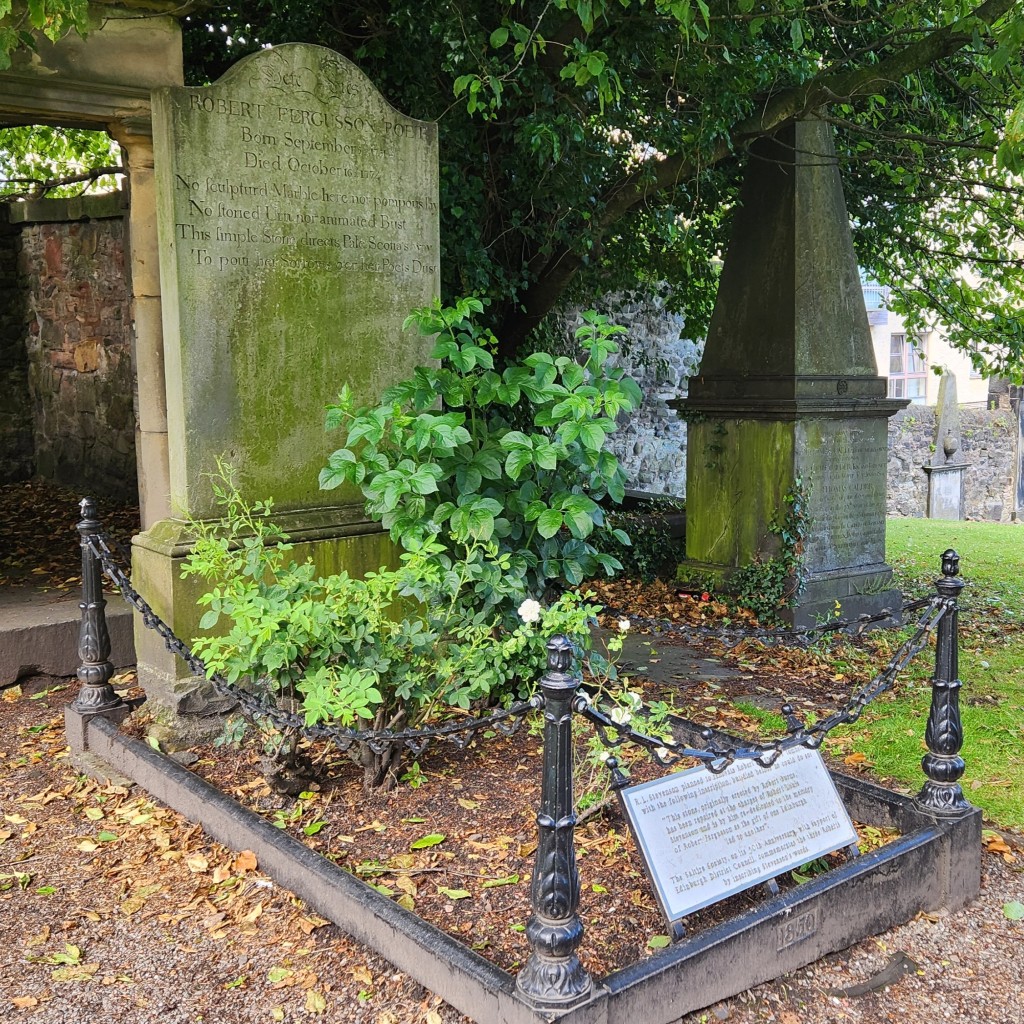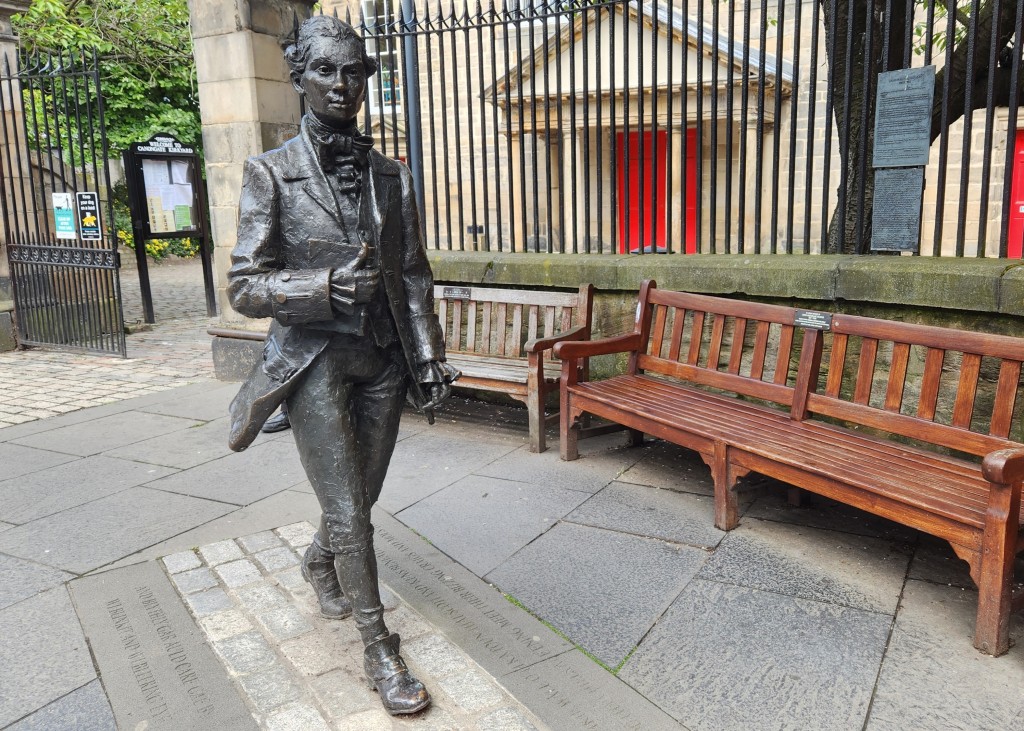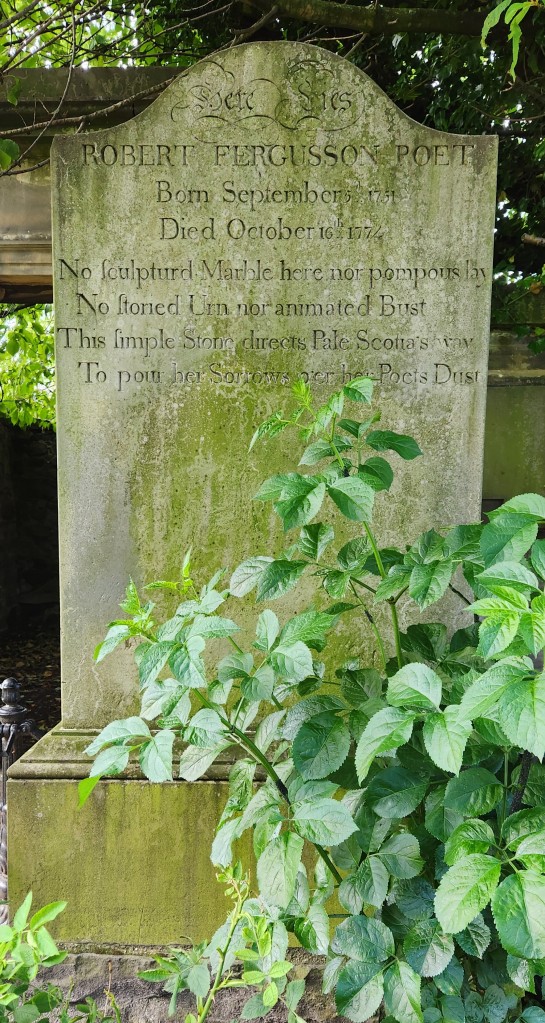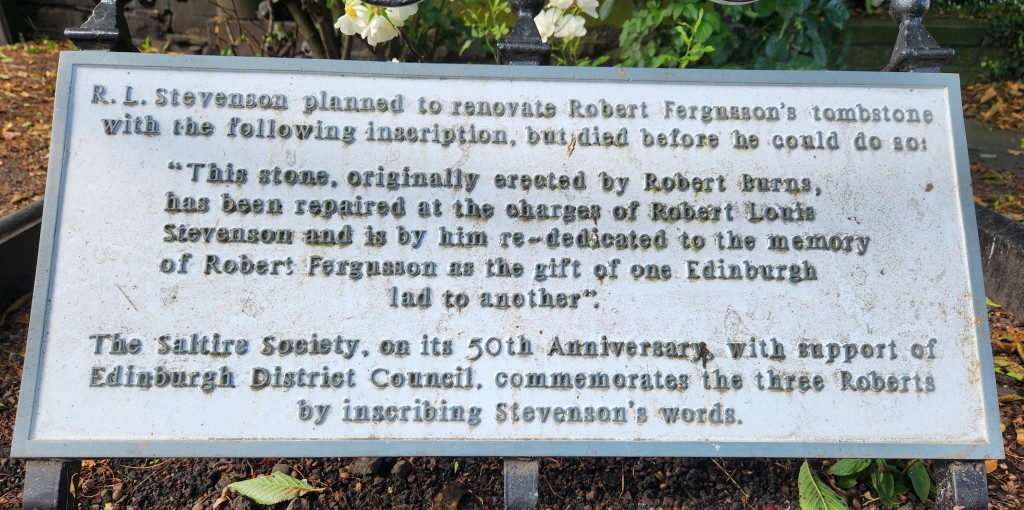I am ashamed to admit that I’d never heard of Robert Fergusson until I reached Edinburgh but the poetry he wrote in his very brief life inspired Robert Burns, Robert Louis Stevenson and untold other Scots.
At the entrance to Cannongate Kirkyard, there’s a 21st century statue of Fergusson striding with book in hand. While I was there, this got a lot of attention from tourists since it’s right on the Royal Mile. Engraved in the pavement on his path are a few lines from his poem about Edinburgh.
Auld Reikie wale o’ ilka toun
That Scotland kens beneath the moon
Whare couthy chiels at e’ening meet
Their bizzing craigs and mous to weet
And blythly gar auld care gae by
Wi’ binkit and wi’ bleering eye
I found the following translation into more modern English.
Old Reekie, best choice of every town
That Scotland knows beneath the moon
Where friendly lads at evening meet
Their dry throats and mouth to wet
And happily bid old cares good-bye
With blinking and with bleary eyes
It is safe to assume that Edinburgh and probably all 18th centuries cities were rather stinky. I can assert that things are much better now. I’ve been walking around here for a couple days and haven’t yet heard anyone call out Gardy Loo.
Fergusson died at the age of 24, in a “hospital” to which he had been involuntarily committed then was buried here but his grave was left unmarked. About twelve years later, when Robert Burns came to Edinburgh, having made good money off his first book of poetry, he commissioned a stone to mark the grave. About a hundred years later, Robert Louis Stevenson wanted to add some lines but died before he could get it arranged. Fortunately, the Saltire Society erected a small plaque another hundred years later.
We’re just a few months from the 250th anniversary of his death, so I’ll commend this Scottish Poetry Library page on Robert Fergusson for your reading.
Also in the churchyard are buried the 18th economist, Adam Smith, who was a contemporary of Robert Fergusson, and Mrs Agnes Maclehose, the muse for Burns’ song Ae Fond Kiss. They had a rather passionate correspondence over a couple of years while she was estranged from her husband. Apparently unconsummated, they used pseudonyms in their letters, he was Sylvander and she Clarinda.






I didn’t know of Robert Ferguson either. Thank you for brining him to my attention.
LikeLiked by 1 person
Always happy to introduce new poets to new readers.
LikeLiked by 1 person
Ah, but that we obtain
a lyrical poets fame
and a headstone bearing our name!
Gypsie-Ami
LikeLiked by 3 people
We should all be so lucky!
LikeLiked by 1 person
🍀🍀🍀
LikeLiked by 1 person
Such a sad, short life …. tragically all too uncommon
LikeLiked by 1 person
Especially in the 18th century.
LikeLiked by 1 person
Interesting. Goes to show, only the good die young.
So I followed the link and tried to read another of his poem. Didn’t understand most of them and wondered if they were even in England.
“I found the following translation into more modern English.”
That’s just it. Was that “English” or Scottish?
LikeLiked by 1 person
I’m no expert in Scots Gaelic but when I read Fergusson’s or Burns’ works, I can make out a lot of it as being English-ish just with the occasional word which I assume is from the Gaelic.
But, there’s a channel on my hotel TV that’s only in Scots Gaelic and I can’t understand anything except for “new” words which are grabbed from English.
LikeLiked by 1 person
There’s a difference between Scots Gaelic (sometimes Irish is referred to as Gaelic and Scots as Gallic) and the Scots dialect – Robert Burns for example, wrote in Scots Dialect. As you say – an English speaking person can pretty much work out what’s being said/written in dialect – but actual Gaelic/Gallic are…whole other languages.
I have a fondness for ‘The Gowden Locks O’ Anna’ …
https://www.bbc.co.uk/arts/robertburns/works/the_gowden_locks_of_anna/
…tho’ mostly consider Mr Burns to have been a randy so-and-so who maybe would have benefited from having a padlock on his breeks – the Robert Plant of his time!
LikeLiked by 2 people
That makes so much more sense. Thanks, Bernie!
And, Burns was definitely a randy so-and-so. I’m pretty sure I found another grave of another of his muses the previous time I was in Edinburgh.
LikeLike
Some more things for me to look for when we go there next year.
LikeLiked by 1 person
Edinburgh is one of my favorite cities. So much to do and plenty of space to do nothing.
LikeLiked by 1 person
What an interesting piece of literary history. Thank you so much for sharing.
LikeLiked by 1 person
Thanks for reading, LuAnne.
LikeLiked by 1 person
Thank you Bart for this very interesting post … 🌝📘
LikeLiked by 1 person
Thanks for commenting, Ivor.
LikeLiked by 1 person
You’re welcome Bart
LikeLiked by 1 person
Thanks for sharing this My Friend. A new poet for me. Have a great day.
LikeLiked by 1 person
Glad to introduce you two.
LikeLiked by 1 person
Cheers. Will definitely look him up. ☕️📖
LikeLiked by 1 person
For Bart….
‘Lang may yer lum reek
But preferably not so
Yer breeks!’
LikeLiked by 1 person
Thank you, Bernie!
LikeLiked by 1 person
What a fascinating article. I’d never heard of him either. I’ll have to look up some of his poetry. Thank you!!
LikeLiked by 1 person
You’re very welcome, Laura! That’s the joy of traveling and exploring cemeteries.
LikeLike
Pingback: The Grave of William McGonagall | Bartholomew Barker, Poet
Pingback: The Grave of William McGonagall – Zack